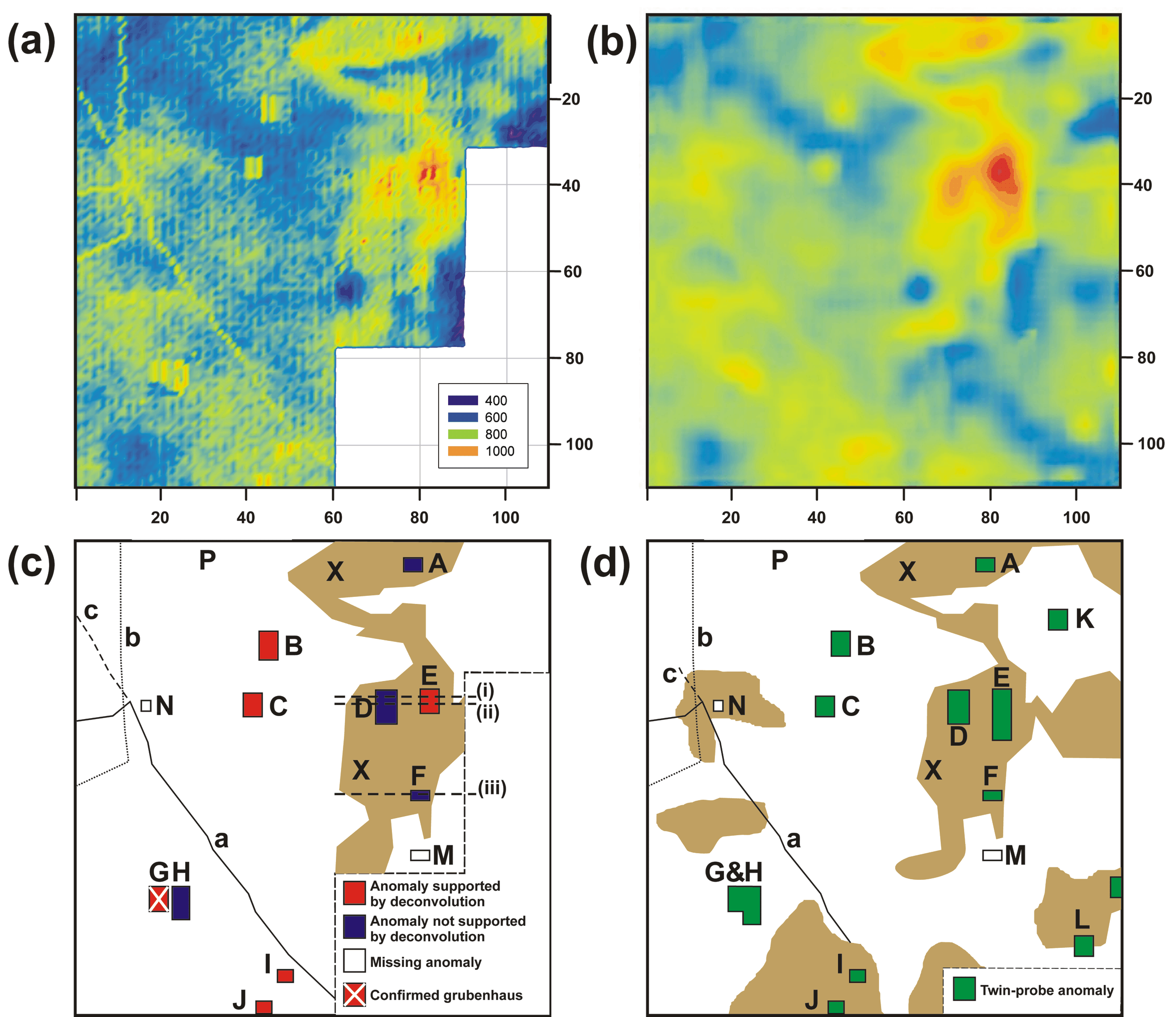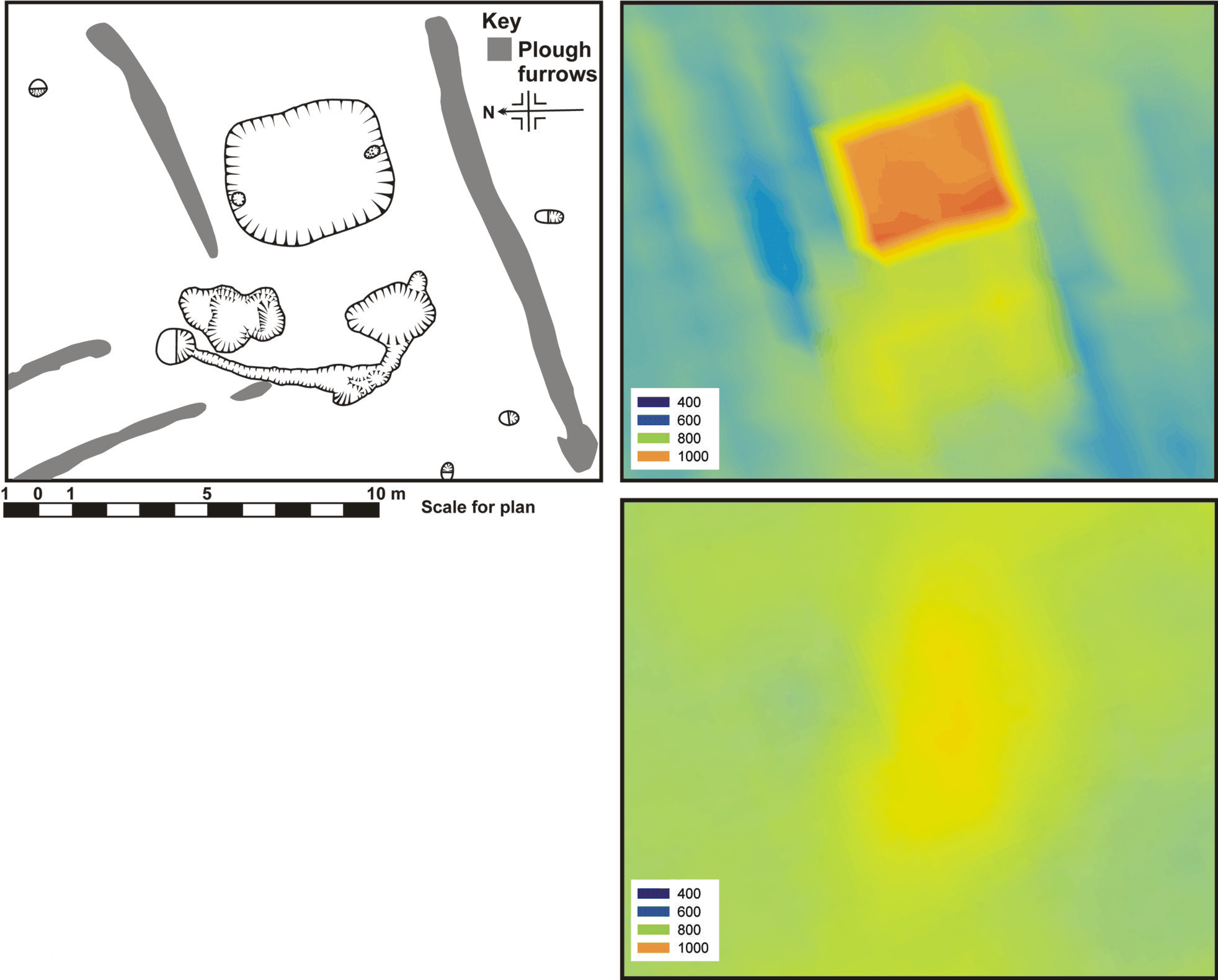

The Use of Electrical Methods in Archaeological Prospecting
The discovery of buried archaeological features has been a side-interest of mine since my MSc at the University of Newcastle upon Tyne. It was there that we developed instruments to prospect for buried houses called Grubenhauser. We were even able to predict the presence of a Grubenhaus that was subsequently confirmed by excavation. However, at the time we lacked the numerical analysis power to interpret the data fully. More recently we have revisited the data using predictive deconvolution techniques to extract more information. Predictive deconvolution is analogous to looking at the data with a magnifying glass - the data can be sharpened if the predicted characteristics of the deconvolution match those of the buried feature just as the image on a page is in focus when the magnifying glass is at the correct distance from the page.

The electrical surveys of new Bewick (a) Wenner raw data, (b) Twin probe raw data, (c) interpreted Wenner anomalies including possible Grubenhäuser in red and blue as well as linear pit alignments and buried ditches or enclosures, (d) interpreted Twin-probe anomalies including possible Grubenhäuser in green as well as linear pit alignments and buried ditches or enclosures.
In a recent report of the work we say that twin-probe and 33-fold multiplexed wenner electrical resistivity surveys were carried out at New Bewick, Northern UK to examine the extent of cropmarks and potential Grubenhäuser (sunken-floored buildings). The twin-probe method was faster, but provided data with a lower spatial resolution. However, the wenner array data was affected by characteristic 'M' or 'W'-shaped responses over filled excavations such as those expected to represent a Grubenhaus. The raw wenner array data were then analysed using 1D and 2D predictive deconvolution in order to remove these artefacts. The deconvolution was carried out using an inverse matrix element method. The filtered results indicate the presence of anomalies consistent with the presence of at least 6 Grubenhäuser and other anomalies concurrent with the linear crop-marks. One particular anomaly measured about 5 m by 4 m and with a pit depth of 0.6 m below 0.3 m of topsoil. This anomaly was subsequently excavated and a Grubenhaus was discovered at the site. The excavated Grubenhaus measured 4.7 m by 3.9 m with a pit depth of 0.5 m below the base of the topsoil, confirming the electrical survey results.

The excavation plan of the discovered Grubenhaus (top left), together with the results of the electrical resistivity survey data (right). The raw data is on the bottom right and the data analysed by predictive deconvolution is on the top right.
Bibliography
Glover, P.W.J., The Use of Electrical Surveying and Predictive Deconvolution in the Search for Anglo-Saxon Grubenhäuser at New Bewick, Northumberland, UK, in J.-F. Moreau, R. Auger, J. Chabot, A. Herzog (eds), 2008, Proceedings, 36th International Symposium on Archaeometry, Quebec, Université Laval, CELAT, Série Archéométrie, xxx-xxx, 2008. [pdf] in colour, [pdf] in black and white.
Glover, P.W.J., The discovery of an Anglo-Saxon Grubenhaus at New Bewick, northern UK using electrical surveying and predictive deconvolution, submitted to J. Archaeological Science.
Glover, P.W.J., The use of deconvolution of electrical resistivity data to aid the search for buried grubenhaüser, 19th General Assembly of the European Geophysical Society, 1994.
Glover, P.W.J., The discovery of an Anglo-Saxon grubenhaus at New Bewick, northern UK using electrical surveying and predictive deconvolution, Oral, ISA 2006, 2-6 May 2006. [pdf]
Glover, P.W.J., The discovery of an Anglo-Saxon grubenhaus at New Bewick, northern UK using electrical surveying and predictive deconvolution, Oral, EGU 2007, EGU2007-A-10463, 15-20 April 2007. [pdf]
Presentations
Glover, P.W.J., Magnetic susceptibility measurements on ancient and modern potsherds using a fast, cheap and portable probe, Poster, EGU 2009, EGU2009-262, Vienna, 19-24 April 2009. [abstract] [poster]
Glover, P.W.J., Archaeometric prospection using electrical survey predictive deconvolution (ESPD), Oral, 2009 Joint Assembly, GP10, Toronto, 24-27 May 2009. [abstract] [presentation]
Glover, P.W.J., Magnetic susceptibility of ancient and modern potsherds using a fast, cheap and portable probe, Poster, 2009 Joint Assembly, GP10, Toronto, 24-27 May 2009. [abstract] [poster]
© Copyright, Paul Glover 2008, 2009: Last updated 03/03/2009